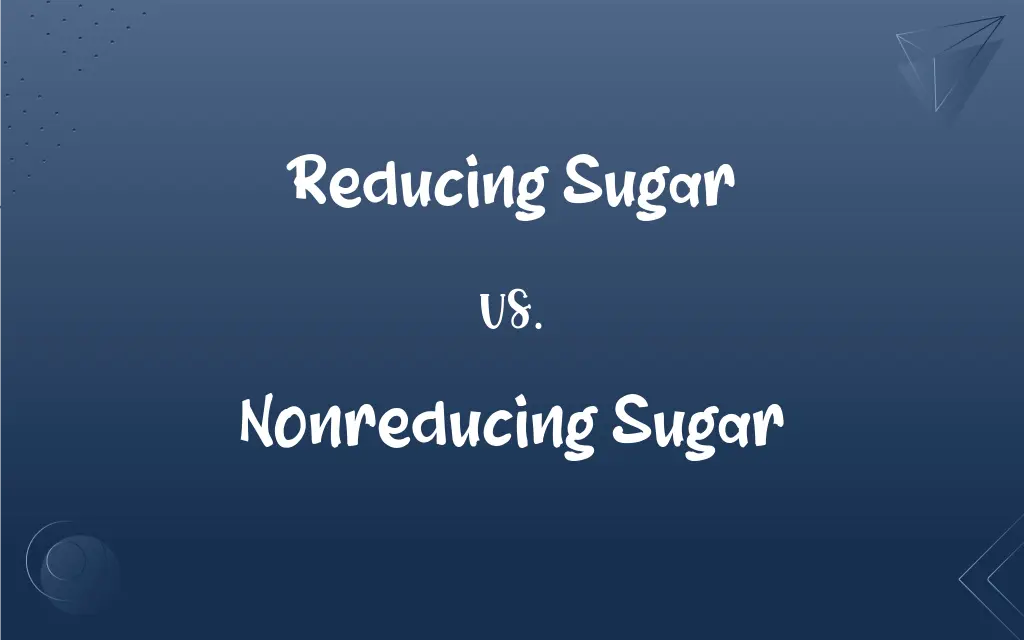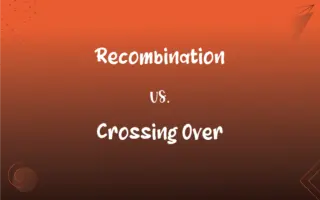Reducing Sugar vs. Nonreducing Sugar: What's the Difference?
Edited by Janet White || By Harlon Moss || Updated on October 16, 2023
Reducing sugars can donate electrons in reactions; nonreducing sugars cannot.

Key Differences
Reducing sugars are carbohydrates that have free aldehyde or ketone groups, which allow them to act as reducing agents. Nonreducing sugars, on the other hand, lack these free functional groups and, thus, cannot reduce other compounds. The ability of reducing sugars to donate electrons makes them react with certain reagents, like Benedict's solution, turning the solution from blue to brick red upon heating. In contrast, nonreducing sugars will not show this color change when treated with the same reagents.
Reducing sugars, due to their free aldehyde or ketone groups, can participate in the Maillard reaction, which is responsible for the browning effect seen in certain foods during cooking. Nonreducing sugars do not possess these reactive groups and therefore do not undergo the Maillard reaction in the same manner. This distinction is crucial in food science, where the type of sugar used can influence the color, taste, and texture of the final product.
In the realm of biochemistry, the difference between reducing sugars and nonreducing sugars is significant. Reducing sugars, such as glucose and fructose, can easily engage in reactions due to their free functional groups. On the other side, nonreducing sugars, like sucrose, have their functional groups involved in glycosidic bonds, rendering them less reactive. This structural difference impacts how these sugars are metabolized and utilized by the body.
Reducing sugars can be identified using specific tests, like the Benedict's test or Fehling's test, both of which rely on the sugar's ability to donate electrons and reduce copper(II) ions to copper(I) oxide, producing a color change. Nonreducing sugars, lacking this ability, will not produce a positive result in these tests unless they are first hydrolyzed to release a reducing sugar component. For instance, sucrose, a nonreducing sugar, can be broken down into glucose and fructose, both of which are reducing sugars.
In various industries, from food to biochemistry, understanding the characteristics of reducing sugars and nonreducing sugars is crucial. While reducing sugars actively participate in reactions due to their free functional groups, nonreducing sugars remain less reactive due to the absence of these groups. This difference not only affects the way these sugars interact with other substances but also influences their roles and effects in various processes and applications.
ADVERTISEMENT
Comparison Chart
Chemical Property
Contains free aldehyde or ketone groups.
Lacks free aldehyde or ketone groups.
Reactivity
Can act as reducing agents.
Cannot act as reducing agents.
Benedict's Test
Turns blue Benedict's solution to reddish.
No color change with Benedict's solution.
Example
Glucose.
Sucrose.
Role in Reactions
Actively participates due to its structure.
Remains passive in reactions.
ADVERTISEMENT
Reducing Sugar and Nonreducing Sugar Definitions
Reducing Sugar
Reducing sugars can act as reducing agents.
Fructose, another reducing sugar, donates electrons in certain reactions.
Nonreducing Sugar
Nonreducing sugars can't donate electrons in reactions.
Consuming lactose, a nonreducing sugar, won't impact Benedict's solution color.
Reducing Sugar
Reducing sugars change Benedict's solution's color upon heating.
A solution with maltose, a reducing sugar, turns reddish when heated with Benedict's.
Nonreducing Sugar
Nonreducing sugars lack free aldehyde or ketone groups.
Sucrose, a nonreducing sugar, doesn't have the reactive functional group.
Reducing Sugar
Reducing sugars are often involved in oxidation-reduction reactions.
In biochemistry, glucose's reducing property is essential in various processes.
Nonreducing Sugar
Nonreducing sugars don't participate as reducing agents.
In experiments, sucrose's nonreducing nature becomes evident when it doesn't alter the state of other substances.
Reducing Sugar
Reducing sugars possess free aldehyde or ketone groups.
Glucose, as a reducing sugar, easily reacts in many chemical scenarios.
Nonreducing Sugar
Nonreducing sugars are structurally different from reducing sugars.
Sucrose, in its structure, lacks the groups that make a sugar reducing.
Reducing Sugar
Reducing sugars are electron donors in reactions.
Galactose showcases reducing properties in chemical tests.
Nonreducing Sugar
Nonreducing sugars remain unreactive in Benedict's test.
Adding trehalose, a nonreducing sugar, to Benedict's solution results in no color change.
FAQs
Give an example of a reducing sugar.
Glucose is an example of a reducing sugar.
Do nonreducing sugars change the color of Benedict's solution?
No, they result in no color change with Benedict's solution.
Are disaccharides always nonreducing sugars?
No, some disaccharides like lactose are reducing, while others like sucrose are nonreducing.
Why is it important to distinguish between reducing and nonreducing sugars?
It helps in understanding their chemical behavior and potential reactions.
Do nonreducing sugars have a sweet taste?
Yes, some, like sucrose, are sweet-tasting.
Do reducing sugars play a role in the Maillard reaction?
Yes, the presence of reducing sugars is essential for the Maillard reaction, which is key in food browning.
What's a defining feature of reducing sugars?
Reducing sugars contain free aldehyde or ketone groups.
What happens when a reducing sugar is heated with Benedict's solution?
The solution turns from blue to reddish.
Are all carbohydrates either reducing or nonreducing sugars?
No, but many simple sugars fall into one of these categories.
Why don't nonreducing sugars react in Benedict's test?
They lack the free aldehyde or ketone groups needed for the reaction.
Is fructose a reducing sugar?
Yes, fructose is a reducing sugar.
How do reducing sugars participate in body metabolism?
They play roles in various metabolic pathways due to their reactivity.
Are all monosaccharides reducing sugars?
Most common monosaccharides are reducing sugars due to their free aldehyde or ketone groups.
Can nonreducing sugars act as reducing agents?
No, nonreducing sugars cannot act as reducing agents.
Why are reducing sugars called so?
They're named for their ability to reduce other substances in reactions.
Can a nonreducing sugar become a reducing sugar?
Yes, through hydrolysis, some nonreducing sugars can break down into reducing sugars.
Can the structure of a sugar determine its reducing or nonreducing nature?
Yes, the presence or absence of free aldehyde or ketone groups in its structure is the determinant.
What test can identify a sugar as reducing or nonreducing?
Benedict's test is commonly used.
Name a common nonreducing sugar.
Sucrose is a common nonreducing sugar.
Can reducing sugars be found in fruits?
Yes, many fruits contain reducing sugars like glucose and fructose.
About Author
Written by
Harlon MossHarlon is a seasoned quality moderator and accomplished content writer for Difference Wiki. An alumnus of the prestigious University of California, he earned his degree in Computer Science. Leveraging his academic background, Harlon brings a meticulous and informed perspective to his work, ensuring content accuracy and excellence.
Edited by
Janet WhiteJanet White has been an esteemed writer and blogger for Difference Wiki. Holding a Master's degree in Science and Medical Journalism from the prestigious Boston University, she has consistently demonstrated her expertise and passion for her field. When she's not immersed in her work, Janet relishes her time exercising, delving into a good book, and cherishing moments with friends and family.































































